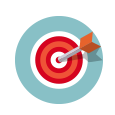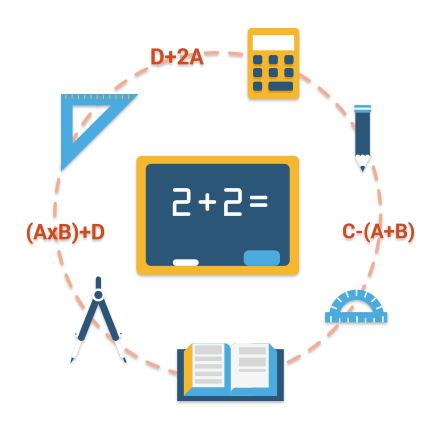Year 7 Maths
Your first year at High School coincides with you beginning to learn Key Stage 3 mathematics. There is a progression from Key Stage 2 to Key Stage 3 and you will learn more complicated topics and subjects at this level during Year 8 Maths and Year 9 Maths. One of the new subject areas you will be taught is Volume, you will receive an introduction to volume using the cubic centimetre as a standard unit, you will also be taught the formula for volume and use this to measure volume of objects too as well as solving problems about volume. At Key Stage 2 mathematics you were introduced to algebraic expressions at a very basic level, however at Key Stage 3 you take this knowledge to the next level. You will learn how to simplify algebraic expressions; adding like terms, subtracting like terms, combining addition and subtraction, multiplication and division. In addition to this you will be taught how to expand algebraic expression using multiplication, a negative multiplier and substitution into algebraic expressions also.
.Popular Maths Curriculum Courses in England.
Key Stage 3
Year 8 Maths
Some of the topics covered include geometric transformations, sequences and series, changing the subject of formula and statistics.
Key Stage 3
Year 9 Maths
Year 9 explains topics such as trigonometric ratios, constructions and loci, circumcentre and incentre and Pythagorean triples.
Key Stage 4
Foundation Maths
Experimental probability, relative frequency, equations involving grouping symbols are some of the areas taught in Foundation Maths.
Key Stage 4
Higher Mathematics
At Higher Mathematics you will be taught surds, surface are formulae and you will also be introduced to circle geometry.



KS 3 Maths Topics
#
TOPIC
TITLE
1
Counting and numeration
Addition to 9999 and beyond
Objective: On completion of the lesson the student will be able to use the student’s knowledge of place value to solve addition problems with 3, 4 and 5 digit numbers and word problems.
2
Subtraction
Subtraction involving four digit numbers and beyond using the renaming method.
Objective: On completion of the lesson the student will be able to use written methods to solve subtraction problems involving 4 and 5 digit whole numbers.
3
Multiplication
Multiplying 2-digit numbers by 2-digit numbers
Objective: On completion of the lesson the student will be able to multiply any 2 digit number by any other 2 digit number.
4
Multiplication
Multiplying 4-digit numbers by 3-digit numbers
Objective: On completion of the lesson the student will be able to multiply any 4 digit numbers by any 3 digit numbers using long multiplication.
5
Multiplication
Multiplying 4-digit numbers by 4-digit number
Objective: On completion of the lesson the student will be able to be able to multiply any 4 digit number by any other 4 digit number using long multiplication.
6
Division/repeat subtraction
Repeated subtraction with divisors greater than 20 with remainders as fractions
Objective: On completion of the lesson the student will be able to use long division by repeated subtraction with divisors greater than 20 and remainders expressed as fractions
7
Division/repeat subtraction
Repeated subtraction with divisors less than 35 with some remainders
Objective: On completion of the lesson the student will be able to use long division by repeated subtraction with divisors less than 35, with some remainders.
8
Division/repeat subtraction
Repeated subtraction with divisors less than 55 with dividends of 3 and 4-digits with some remainders
Objective: On completion of the lesson the student will be able to use long division by repeated subtraction with divisors less than 55 and where dividends are 3 and 4 digit numbers, and there are some remainders.
9
Division/repeat subtraction
Repeated subtraction with divisors greater than 50 with dividends of thousands and some remainders
Objective: On completion of the lesson the student will able to use Long Division by repeated subtraction with divisors greater than 50 including division of thousands, and some remainders.
10
Algebraic expressions
Directed numbers: addition and subtraction.
Objective: On completion of the lesson the student will be able to add and subtract positive and negative numbers in any combination, and understand adding and subtracting positive and negative pronumerals.
| # | TOPIC | TITLE | |
|---|---|---|---|
| 1 | Counting and numeration | Addition to 9999 and beyond | |
| Objective: On completion of the lesson the student will be able to use the student’s knowledge of place value to solve addition problems with 3, 4 and 5 digit numbers and word problems. | |||
| 2 | Subtraction | Subtraction involving four digit numbers and beyond using the renaming method. | |
| Objective: On completion of the lesson the student will be able to use written methods to solve subtraction problems involving 4 and 5 digit whole numbers. | |||
| 3 | Multiplication | Multiplying 2-digit numbers by 2-digit numbers | |
| Objective: On completion of the lesson the student will be able to multiply any 2 digit number by any other 2 digit number. | |||
| 4 | Multiplication | Multiplying 4-digit numbers by 3-digit numbers | |
| Objective: On completion of the lesson the student will be able to multiply any 4 digit numbers by any 3 digit numbers using long multiplication. | |||
| 5 | Multiplication | Multiplying 4-digit numbers by 4-digit number | |
| Objective: On completion of the lesson the student will be able to be able to multiply any 4 digit number by any other 4 digit number using long multiplication. | |||
| 6 | Division/repeat subtraction | Repeated subtraction with divisors greater than 20 with remainders as fractions | |
| Objective: On completion of the lesson the student will be able to use long division by repeated subtraction with divisors greater than 20 and remainders expressed as fractions | |||
| 7 | Division/repeat subtraction | Repeated subtraction with divisors less than 35 with some remainders | |
| Objective: On completion of the lesson the student will be able to use long division by repeated subtraction with divisors less than 35, with some remainders. | |||
| 8 | Division/repeat subtraction | Repeated subtraction with divisors less than 55 with dividends of 3 and 4-digits with some remainders | |
| Objective: On completion of the lesson the student will be able to use long division by repeated subtraction with divisors less than 55 and where dividends are 3 and 4 digit numbers, and there are some remainders. | |||
| 9 | Division/repeat subtraction | Repeated subtraction with divisors greater than 50 with dividends of thousands and some remainders | |
| Objective: On completion of the lesson the student will able to use Long Division by repeated subtraction with divisors greater than 50 including division of thousands, and some remainders. | |||
| 10 | Algebraic expressions | Directed numbers: addition and subtraction. | |
| Objective: On completion of the lesson the student will be able to add and subtract positive and negative numbers in any combination, and understand adding and subtracting positive and negative pronumerals. | |||
See More Topics Covered in Year 7 Key Stage 3 Maths
..









